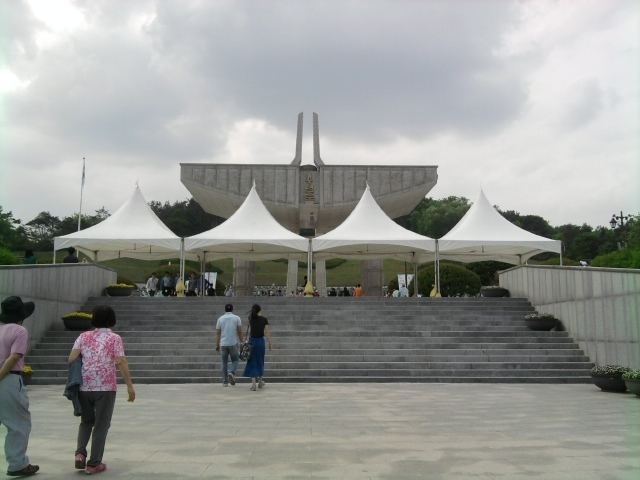Established 1997 Country Korea No. of interments Over 700 Phone +82 62-268-0518 | Type National Cemetery Founded 1997 | |
 | ||
Size 166,201 square metres (1,788,970 sq ft) Similar 국립518묘지관리소, 영락공원묘지, Yeongnak Park, 효령공원관리사무소(시립화장, Park Cemetery | ||
May 18th National Cemetery (Hangul: 518국립묘지, 망월동국립묘지) is a cemetery for those who participated in the Gwangju Uprising. Built by the government of South Korea in 1997, it is located in Gwangju. Every May, on the anniversary of the uprising, it is common for citizens to visit the cemetery to honor the dead.
Contents
History
The Gwangju Uprising, also known as May 18 Democratic Uprising, was a democratic movement in South Korea directed against the Chun Doo-hwan government, which violently suppressed Gwangju citizens. Under the Kim Young-sam administration, there was a movement to make May 18th National Cemetery a democratic shrine.
The previous May 18th Cemetery, or the "Mangweol-dong Cemetery" (구묘역), was the former burial site of those who died during the May 18th Democratic Uprising and the proceeding democratic movement. Some of those interred there for 17 years were delivered to the cemetery in garbage trucks. Due to the cemetery's reputation as a Mangweol-dong, a "holy ground for democracy", the military had plans to destroy the graveyard. Those plans never came to fruition.
Following the democratization of Korea, a plan to create a National Cemetery was announced in 1993, giving rise to the New National Cemetery for the May 18th Democratic Uprising. Construction began in November 1994 and the new cemetery was opened in May 1997. Bodies from the Mangweol-dong Cemetery were exhumed and re-interred in the new location, while the old cemetery was restored to its former state. The new cemetery was promoted to the status of a national cemetery by presidential decree on July 27, 2002, and renamed the National Cemetery for the May 18th Democratic Uprising on January 30, 2006. An annual commemoration is held each May, in which people pay their respect to those who died at both the old and new cemeteries.
Taryn Assaf observed that
The two cemeteries came to represent two different aspects of the uprising: the new, designed to represent a commemoration of past sacrifices and the old marked by the symbolism of a continuing struggle. Interesting to note is the suggestion evident in the process of naming. Equating 'new' with 'official' and 'old' with 'unofficial' serve to influence popular conception of the significance of the different actors involved in the uprising, their place in history, their ideologies and their legacies.
Burials
Notable burials
Old Cemetery (구묘역)
New cemetery (신묘역)
May 18th Memorial Monument
The Memorial Monument consists of two parallel pillars 40 metres (130 ft) tall, based on a traditional Korean "flagpole" design (dang-gan-ji-ju). This monument represents the concepts of new life, survival, and seeds of hope. Near the center point of the pillars is an ovular sculpture, representing "resurrection". To the right and left of the monument are two bronze sculptures called "Grassroots Resistance of May".
Memorial Hall
The Memorial Hall allows visitors to view and interactively experience the events of the May 18th Democratic Uprising. The exhibition includes a historical record of the Uprising, tributes to victims, a virtual tour of important landmarks in the democratic movement, and facilities for educational presentations.
Portrait Enshrinement Tower
This building is designed in the form of a dolmen, a traditional tomb dating to the prehistoric period. Portraits of those who are buried in the May 18th National Cemetery are enshrined on the walls of this building.
Seungmoru
A two-story exhibition space with facilities for viewing video footage of the Gwangju Uprising.
Hill of Democracy
A memorial hill planted with "Trees of Democracy" representing "the will of all Korean people to commemorate the noble sacrifice" of Uprising participants.
Gates
Several memorial gates stand on the grounds. At the entrance is the Gate of Democracy, which contains a visitor guestbook. The Gate Cherishing the Memory of the Deceased stands approximately three stories high. The Gateway to History contains historic photographs and video documentaries.
Art
Numerous statues honor Uprising victims and express hope for peace and justice, including the Bronze Statue of Armed Resistance and the Statue of a Peaceful and Prosperous World. A series of relief sculptures titled "Seven Scenes From History" depicts the history of resistance to oppression in Korea.
